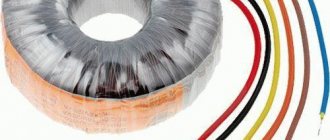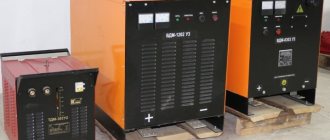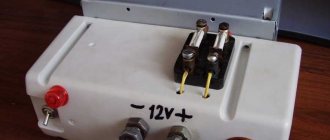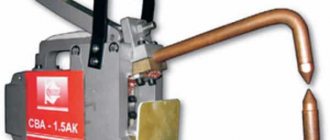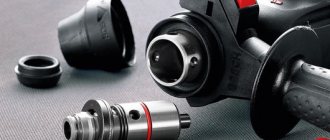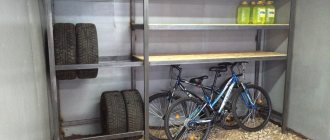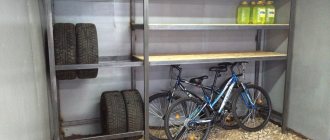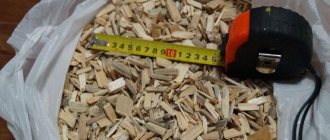Requirements for a transformer product
In order to assemble an output transformer with your own hands, you will first need to understand the following technical issues:
- What circuit will this transformer be connected to?
- What sound power is planned to be obtained at the output of the amplifier with its help.
- What should be the winding characteristics of this device?
Important! Only if all the parameters listed above are chosen correctly will it be possible to construct a high-quality amplifier with excellent sound characteristics over the entire frequency range.
Let us consider each of the conditions for obtaining high-quality amplification in more detail.
Soldering aluminum.
There are many “ways” to solder aluminum. For example, rub a soldering iron tip under some kind of rosin flux and maybe the solder will stick to the aluminum in some place. All this is more like making fire with tinder. Today everyone uses lighters. And for soldering aluminum there is a modern flux F-64, which easily solders aluminum just like rosin flux solders a printed circuit board. But don’t get carried away - when soldering a lot, turn on the ventilation. F-34 flux was made using a completely different chemistry. It is much less active, but also many times safer. Both are fluxes whose residues require removal.
Connection diagram
To make your own amplifier using 6P14P pentodes, you must first select a suitable circuit, which is very easy to do if you have the Internet. To do this, just type the appropriate query in the search bar and select the circuit solution you like best. In this case, it is important to decide on which option the amplifier output unit is supposed to be made of: one or two lamps (one- or two-cycle mode).
Additional information: To obtain high-quality and undistorted sound, preference should be given to the second option (the so-called “two-stroke”).
With this design, the circuit on the left is suitable (for convenience, it includes a preliminary stage on a 6N2P double triode and a power supply with a T2 power transformer).
Types of solder
What types and technologies exist? An experienced professional knows exactly what flux to use for soldering microcircuits, while a novice master must study dozens of technical literature in order to correctly determine the direction. Let's try to analyze in detail each hard metal material where you need to choose the right flux for soldering microcircuits.
- Silver. For this material, a specialized type of flux gel is used for soldering, which prevents the appearance of the so-called oxide film and allows you to degrease the soldering area. According to generally accepted rules, the surface of a silver product must be heated to a certain temperature, where a kind of protective film should form. The flux for soldering microcircuits with silver material is non-flammable and the melting range varies from +520 C to +820 C.
- Brass. In this case, the universal soldering flux SKF is used, which is also used for brass, some metal products, as well as copper, corrosion-resistant materials, galvanized iron, etc. At the end of the working process, a universal processing technology is formed, which includes anti-corrosion surface protection.
- Stainless steel. For the group of stainless metals, it is best to use orthophosphoric acid, which is classified as a middle group of inorganic components. At its core, the material forms hygroscopic miniature colorless crystal materials on its surface. When the temperature reaches +213 C, the flux material for soldering radio components turns into a new material - pyrophosphoric acid. As a result, the finished material has the ability to dissolve well in water, so in most versions it contains an 85% water solution. By the way, the liquid also has excellent ability to dissolve in solvents, as well as in ethanol. The solution also serves as a substance that cleans the surface of the workpiece from rust and other corrosive effects.
- Aluminum. Traditionally, flux is used for soldering microcircuits, which contains tin-lead solder components. But, recently, other materials have been developed for joining aluminum parts, where zinc, as well as cadmium or improved bismuth are used as components. The use of these components ensures high connection of aluminum parts. The correct choice of components for connecting aluminum depends on many minor factors, and often a “binary version of the flux” is used, where orthophosphoric or ordinary phosphoric acid is necessarily present. The no-clean process involves applying the substance in a thin layer, which ultimately produces a whitening effect on the aluminum ends of the workpiece. Upon completion of work, no additional stripping of aluminum is required.
- In radio electronics. For small and simple work with radio electronics, use a do-it-yourself flux for soldering microcircuits based on rosin, which tends to dissolve in an alcohol base. Very often a traditional alcohol-gasoline mixture is used. The main requirement for using these materials is a low degree of current leakage, as well as the lowest possible corrosion rate of the treated surface.
- Black metals. This type of material has special physical and chemical characteristics, therefore, for ferrous metals, zinc chloride-based solder is used, which has either a low (low) or medium activity level. It is recommended to use this type of flux for enamel baths. The active version of solder allows you to remove the oxide film from the surface being processed before starting the work process, as well as reduce the possible tension on the surface of the processing material. Please note that active solder material comes in powder, liquid paste, and pure liquid form. Recently, the industry has been producing a special flux paste that facilitates the work process of soldering the surface of ferrous metal products.
- Copper. To connect any copper surface of a product, a solder base is used, which contains a copper-phosphorus base, with a mandatory component composition of 15% silver. The main characteristic of such solders is the excellent adhesion of copper under extreme operating conditions, which is why this option is often used in the refrigeration industry. High fluidity is one of the positive aspects of solder, which spreads over the entire surface and ensures the filling of the pores of damaged areas of copper pipes.
It will be interesting➡ What is the element base and where is it used
Soldering fat and soldering acid
Soldering fat (can be active or neutral) is needed for the same purposes as rosin, removing the invisible oxide shell from the metal and improving soldering. But if rosin does not cope with this task and cannot remove this shell from the steel, then solder fat - please! If the metal does not want to be tinned, soldering acid is used. The advantages of acid are that it degreases parts for soldering faster and better than rosin and solder fat.
Table of solders for soldering irons for microcircuits.
Its disadvantage is that after soldering it reacts with the metal for a long time, and is also a very good conductor of electric current, so self-respecting electricians and electronics engineers never use it, they have no use for extraneous current paths.
Copper, bronze, brass can be soldered with rosin or flux, lead will not be soldered with rosin, you need to solder with soldering oil. If nickel, steel or iron are used, soldering acid is used; after soldering, the remaining acid must be washed off with water. If there is a choice, then you should still choose solder fat, because... it combines the advantages of both acid and liquid rosin (flux).
Soldering flux in tube
Borax
This is a high-temperature flux (700-900*C), borax is used as a flux for soldering steel, cast iron, copper and its alloys with medium-melting copper, brass, gold and silver solders. Molten borax dissolves metal oxides and cleans the surface of the parts being soldered.
After using borax during soldering, it is necessary to remove the remaining salts using mechanical stripping. Borax and boric acid, when mixed one to one by weight, form boric flux. You need to mix the ingredients, grind thoroughly in a porcelain mortar, dissolve in distilled water while heating and evaporate to a solid residue. To increase the activity of the flux, fluoride and chloride salts are added to the mixture.
This is interesting! All about semiconductor diodes.
Oxidal
Used for cleaning soldering iron tips or for soldering oxidized leads of radio components. For best oxide action, the soldering iron should be at least 40 watts. Oxidal is sold in powder form; when working with it, it emits an unpleasant odor and the area near the soldering becomes covered with “frost.” After soldering with oxide, the residues are removed mechanically.
Oxidal for soldering
Tsaponlak
Tsaponlak is used to cover printing tracks to protect them from external influences, for example, to protect them from moisture. Over time, microcracks may appear at the places where radio components are soldered, and the penetration of water vapor into the crack over time causes the formation of non-conducting oxides.
It will be interesting➡ Making a laboratory power supply with your own hands
Tsaponlak applied to the soldering point forms a strong surface elastic film and protects this place from moisture. Tsaponlak comes in different colors: green, red, blue. It is better to apply it to the board with a brush or soft sponge. I do not recommend covering entire printed circuit boards with tsaponvarnish (or in general with any acetone-containing substances). Special colorless varnishes are sold for these purposes.
output power
The output power for the circuit under consideration can range from 12 to 25 watts (with a load resistance of 4 ohms).
Note! In maximum power mode, the distortion factor in this case will be no more than 5%, and the output voltage on the winding of the sound transducer is about one volt.
To obtain optimal power, it is more convenient to count the secondary winding of a push-pull device on the number of turns that corresponds to the complex resistance of the connected speaker (4 or 8 Ohms).
it is my choice
my choice F-2000 flux paste for fine electronics Removal is not necessary! I've been using it since 2002. pleased
Last edited by ACORDGSM; 12/18/2009 at 10:37 pm.
I have been using FLUX PLUS for a long time, about 4-5 years, it is economical, convenient to use not only with cell phones. My partner in household appliances tried it once, and now he uses it all the time.
I use FLUX PLUS 6-412-A, I haven’t found a better one yet.
Cookson Electronix ALPHA RMA7 Flux gel
Likewise. The paste is excellent, but after it the residues are difficult to wash off. A “crust” remains, and as time passes the soldering becomes noticeably darker. It is completely removed with Galosh gasoline. There are no further consequences. Moreover, this paste is a restorative paste for soldering products subject to corrosion - for “drowned people”.
Main characteristics
Before winding the output transformer for 6P14P, you should familiarize yourself in more detail with its design, which has the following characteristics:
- The converter consists of two windings representing its primary and secondary multi-section coils.
- The transformer for the lamp device is wound on an Ш30 core.
- The thickness of the set of its plates is 36 mm.
To accommodate both coils of the output transformer for push-pull on 6P14P, the dimensions of its working window must be selected at least 60 by 30 mm.
With such design data of the converter, its winding parameters take on very specific values, which are discussed in the next section.
Winding characteristics of the output transformer
In order to wind the output transformer for a push-pull amplifier on 6P14P, you will need to make a double frame, artificially separated by a special partition.
The location of the winding sections on the transformer frame for 6P14P lamps, as well as the connection diagram for the primary and secondary windings, are shown in the photo.
The primary winding frame has six equally sized sections, each containing 300 turns. The secondary coil is divided into 4 sections containing 44 turns.
Winding sequence
The sequence of winding them with your own hands looks like this:
- First of all, the turns are wound in the sections of the frame, indicated in the photo by numbers 1,8,2,7,3.
- After this, the partially wound structure is removed from the machine and rotated 180 degrees.
- At the next stage of work, winding of the remaining sections, numbered 4,9,5,10,6, continues.
All sections of the primary winding of the output transformer for a 6P14P tube amplifier are connected to each other in a series circuit. In contrast, the secondary coil consists of two halves connected in series, each of which contains two sections connected in parallel.
Additional information: Thanks to this method of forming the coils, the transformer device provides optimal transfer characteristics of the cascade.
The latter means that when the secondary winding is constructed in sections, its coordination with loads of various sizes is simplified.
In addition, this approach to winding coils with your own hands allows you to obtain a symmetrical circuit with a low inductive leakage coefficient. Thanks to this, the assembled cascade has excellent frequency response and phase response characteristics.
What to use it for
A novice solderer does not always appreciate the importance of the functions performed by fluxes.
There are parts, solder, soldering iron or other tools for soldering. I warmed everything up, connected it, cooled it, washed it - and it was done. In fact, the process is more complicated. Only surfaces free of oxide deposits and other impurities can bond reliably.
The solder should spread evenly in the required place, and not just anywhere. The materials must have a suitable combination that maximizes adhesion.
To do this, you need to reduce the tensile forces on the surfaces. For many types of soldering, environmental influences are not allowed. It is necessary to isolate the work area from the surrounding atmosphere.
Therefore, the main functions of flux are as follows:
removal of oxide deposits and impurities,- ensuring good solder distribution,
- improving adhesion of materials,
- protection of the connection point from air and moisture.
A good flux composition can handle all tasks. There are many of them on sale. You can make good compositions at home, but it is better to buy ready-made compositions that have been tested many times in their work.
Choosing a flux for soldering is easy. You need to have information about the available brands and take into account the specifics of the upcoming soldering.
Power transformer parameters
In order to make a power transformer for a 6P14P tube amplifier, you will need to use a magnetic core based on Sh-40 electrical steel, which has a set thickness of 50 mm. The winding parameters of the converter device are as follows:
- The primary (network) winding should have 430 turns of copper wire in PEL 0.8 insulation.
- Its secondary coil should be wound with PEL-0.31 wire, the number of turns of which should be at least 400 (it powers the rectifier, which provides anode voltages for the lamps).
- In the winding of the filament circuit of the double triode 6N2P (b-b), it is necessary to wind 11 turns of PEL-1.0 wire.
The supply windings operating on the incandescent circuit of lamps L4 and L5 (v-v) each have 13.5 turns of PEL 1.0 wire. Upon completion of the assembly of the power unit, a complete set of electrical devices will be ready for installation in the working circuit.
If all the requirements outlined in the article are met, it is possible to obtain a high-quality output transformer for 6P14P lamps, which guarantees reliable operation of the push-pull amplifier stage.
With weak acids and borax
Many craftsmen try to choose time-tested products for soldering. They prefer to work with stainless steel, nichrome, and some other metals and alloys, using concentrated phosphoric acid.
Flux is available and inexpensive. Its main disadvantages include the ability to form products that conduct electric current well. If this circumstance significantly worsens the performance of the soldered part, you should choose a different flux.
For soldering metal parts with soft solders, a group of mixtures with the designation LTI is recommended. There are several varieties of these products containing different ratios of several nitrogen-containing compounds.
For each type of flux of the LTI group, there are strictly defined recommendations that must be taken into account.
High-temperature soldering of cast iron, copper alloys, and steels with a high carbon content is carried out using borax as the flux. Its melt removes oxides and other impurities well. After work, the soldering area can be easily cleaned mechanically.
Compound
The composition of flux 209 and 209X is identical, the ratio of the amount of materials is also no different. The regulatory document contains information regarding the content of individual elements in the composition of the material:
| boron | 12,8±0,5% |
| fluorine | 27,6±0,9% |
| potassium | 34,95±1,45% |
| oxygen | 24,65±2,85% |
Component composition 209 includes:
| potassium fluoride | 42±1% |
| boron oxide | 35±1% |
| potassium tetrafluoroborate | 23±1% |
The first component complies with State Standard 20848-75; it first undergoes a dehydration procedure. The second component was obtained as a result of heat treatment of boric acid grade B (Gosstandart 18704-78) at a temperature of 550 degrees, the secondary reaction product is boric anhydrite in the form of granules. The third component is obtained as a result of a chemical reaction of potassium hydroxide grades Ch, D, A (State Standard 24363-80) and boric or hydrofluoric acid grade A (30 percent). The material is a loose composition of fine particles that have a white tint; there are no third-party elements in it.
The components of 209X include:
| boric acid | 35,8±1% |
| potassium hydroxide oxide | 28,9±1% |
| hydrofluoric acid | 35,3±1% |
The following users thanked cliviy for this post:
In general, there are 5 types of flux on hand for work: regular rosin (you never know), Chinese but not (underneath it I remove the remaining solder in non-critical areas of work. In general, I save on expensive ones, I wash them off afterwards), liquid Soviet one for soldering aluminum (a very brutal thing, oxides a puddle with a bang, of course I wash it off), LTI (I lift the mikruhi with its help, the liquid goes well under the mikruhu, it boils and the BGA starts to move away at the same time, so you can see how it moves, I definitely wash it afterwards) and finally RMA 223 (working with the BGA , reballing, I try to wash everything) and also some kind of active Soviet liquid (I don’t use it for fuels and lubricants).
The most interesting videos on Youtube
Those who want to delve deeper into the calculations can download a very good book with examples of complete calculations of a transformer, the link to which is at the end of the article. Also at the end of the article there is a link to several programs for calculating transformers.
Related topics.
Power supply for low frequency amplifier from available parts. ULF, part 3.
How to connect Notepad with the Windows Calculator to make calculations easier?
